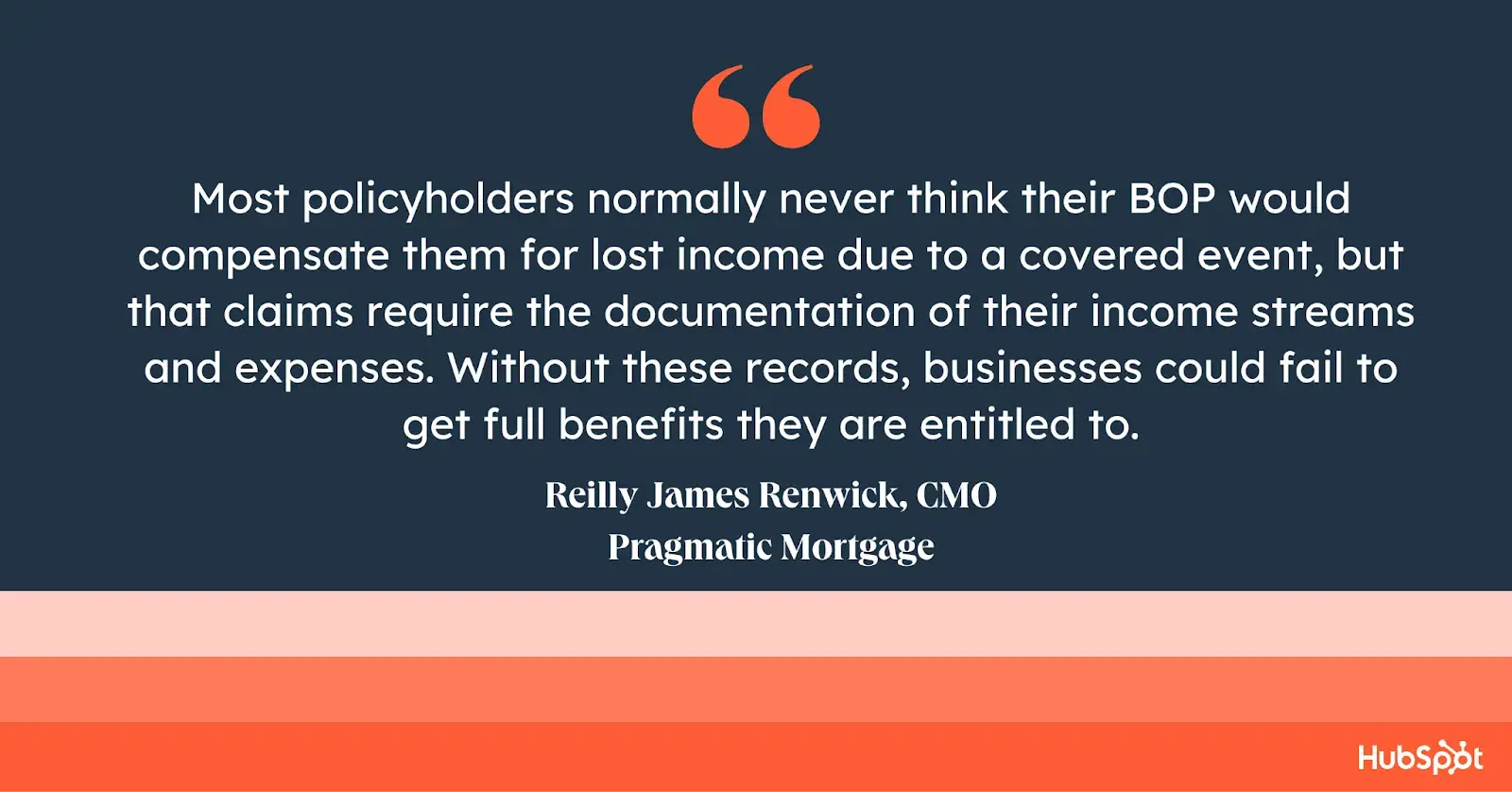
Insurance gives you an extra layer of coverage when life throws an emergency your way — whether that be a run to the doctor, the mechanic, or the dentist. If you own a business, you can tap into that extra protection with a business owner’s policy.
In my years reporting on business and finance, I’ve learned that launching a business is fraught with challenges. Business owner’s policies are one type of insurance that can help mitigate some of these risks. That may include protection from theft, lawsuits, and unforeseen accidents.
In this article, I take a deep dive into the ins and outs of business owner’s policies. I’ll explain which businesses benefit most from this type of coverage and what to look for if you need to shop for the right option. Let’s dive in.
Table of Contents
- What is a business owner’s policy?
- What does a business owner’s policy cover?
- Business Owner’s Policy Benefits
- Cost of BOPs
What is a business owner’s policy?
A business owner’s policy is a type of insurance designed for small- to medium-sized operations with fewer than 100 employees. Also known as a BOP, a business owner’s policy is “designed to shield from things that can cause big harm to business,” said Sam Taylor, an insurance expert at the consulting firm LLC.org.
These plans bundle several types of coverage, according to Gregg Barrett, CEO of the property and casualty administration software firm the WaterStreet Company. These plans often focus on protecting the business’ assets, shielding owners from potential lawsuits, and covering losses during an emergency. Putting all these protections in one plan can help owners manage their coverage more easily.
What does a business owner’s policy cover?
Barrett notes that business owner’s policies offer three core protections:
- Protection for the business property.
- General liability insurance.
- Lost income and operating costs caused by interruptions in business operations.
Converging a business’ property includes the space itself, equipment, furniture, and inventory. Plans often protect these assets both from unplanned accidents and targeted damage. For example, fire, theft, vandalism, and natural disasters are often all covered.
Liability insurance involves covering “legal costs, medical, [or] property damage caused to others,” Barrett told me. For example, if a customer sued a business for an accident that happened in the shop, a business owner’s policy can help cover the cost.
The third category covers lost income and operating expenses if your business is forced to close. Let’s say your area is evacuated during a fire or closed during a pandemic, your BOP can compensate some of your losses.
Reilly James Renwick notes that interruptions are often overlooked.
“Most policyholders normally never think their BOP would compensate them for lost income due to a covered event, but that claims require the documentation of their income streams and expenses. Without these records, businesses could fail to get full benefits they are entitled to,” says Renwick, chief marketing officer of the mortgage broker firm Pragmatic Mortgage.
Certain business owner’s policy providers allow you to add other types of coverage to your plan. For example, Barret notes that some insurers allow business owners to add coverage for cyber liability, data breaches, and professional liability. That’s a suggestion to strongly consider, as data breaches are on the rise.
Pro tip: Study what your BOP covers to make sure you’re getting the most out of your policy.

Business Owner’s Policy vs. General Liability Insurance
A BOP is much more comprehensive than general liability insurance. In fact, a BOP typically includes general liability insurance, whereas the reverse isn’t true. The chart below, provided by WaterStreet Company and edited for clarity, shows the similarities and differences between the two types of insurance offerings.
|
Business Owner’s Policy (BOP) |
General Liability Policy |
|
|
Coverage |
Combines general liability, property insurance, and business interruption coverage |
Covers third-party bodily injury, property damage, and advertising injury; that includes defamation, libel, slander, copyright infringement |
|
Property Insurance |
Yes, includes coverage for business property and equipment |
Does not cover business property |
|
Business Interruption |
Yes, covers loss of income due to a covered event, such as a storm or fire |
Does not cover business interruption |
|
Customization |
Can be customized with additional coverages, including professional liability, data breach, and employee dishonesty |
Can be customized with endorsements for specific risks, but only relative to liability |
|
Ideal For |
Small- to medium-sized businesses looking for comprehensive coverage on many aspects of the enterprises |
Businesses needing basic liability protection |
Business Owner’s Policy Benefits
In my opinion, a BOP’s best benefit is the same as any other insurance: the peace of mind it offers. That’s of even greater value to business owners, who have a tough, headache-filled job to begin with. You may even be covered for lost income and operating costs if you are forced to close. With a BOP, a risk-filled endeavor gets a little less risky.
Beyond that, the insurance can save you money when you face an emergency. Let’s take a look at copyright infringement, an example I have personal experience with.
I published an article in Cosmopolitan, and the company I reported on asked whether they could send a copy of the piece to prospective clients. I said yes and quoted them a price for the opportunity. I later found out they were sending it out without paying me. I hired a lawyer and dealt with the back-and-forth until we reached an out-of-court settlement.
A BOP could have benefitted both of us. The company went through the hassle and expense of legal fees. They ended up paying me more than I would have charged them. If they had a BOP, they wouldn’t have needed to front the cost. And, if I had a BOP, I could have sought compensation through my policy. I wouldn’t need to find a lawyer and go through the trouble firsthand.
Another plus is that the BOP combines a fairly comprehensive range of coverages into a convenient package. Business owners don’t have to spend hours researching different types of policies for every imaginable emergency — comparing every fire insurance provider, then repeating for general liability. Beyond that, one bundle is cheaper than buying each policy separately.
What type of business is eligible for a BOP?
To be eligible for BOP insurance, a business must employ less than 100 employees, maintain a small office or commercial space, bring in less than $1 million in annual revenue. The business owner also needs to have less than one year of business interruption insurance, according to the insurance broker site TechInsurance.com.
Retail stores, restaurants, contractors, manufacturers and sales offices are among the types of businesses that are eligible for BOP coverage, noted Farmers Insurance, which sells these policies.
What knocks some businesses out of eligibility is if they have a home-based business. For example, a barber shop in a retail space would be covered. Meanwhile, a barbershop based out of your garage would not. If your business is set up in your home, a homeowner’s policy can typically offer some coverage.
Cost of BOPs
Premium costs can vary depending on the type of business you run, where your business is located, how many moving parts need to be insured, and how long you’ve been in business.
Your property values and the number of employees will also affect what you pay. Additionally, businesses in densely populated locations often fork over steeper rates than those in small towns or rural areas.
“On average, you can expect to pay between $500 and $5,000 per year for a policy,” said Barrett.
Higher-risk businesses, like restaurants or contractors, will tend to pay more because of their increased exposure to liability and property damage. For example, a construction business uses heavy equipment and handles projects in dangerous environments, raising the price. Similarly, restaurants are fast-moving, with heat and sharp knives thrown into the mix, increasing the likelihood of injuries.
According to insurance provider The Hartford, major insurers start plans at around $85 per month or $1,019 annually. Progressive’s BOPs start at $113 per month or $1,319.
“In the past 20 years, prices have increased by about 20% to 30%, mostly because of inflation and more claims,” said Taylor. She added that business owners must factor in the premium hikes when planning their next year’s budgets.
Pro tip: “Cheap is expensive” is advice I got from a wise businesswoman years ago. I’ve incorporated that thinking into every purchase I’ve made since then, whether it’s for clothing, technology, furniture, or insurance.
When I come across a policy premium that is much cheaper than what seems to be the going rate, I investigate and ask myself what coverage it offers, what are the deductibles and how reputable are the insurers about honoring their commitment to policyholders. If I go with the lowest quote, I may end up paying much more later when a problem arises.
Securing Your Coverage
Take it from someone who is insured in many areas of her life: Insurance is necessary. If you have a small- to medium-sized business, you need a solid BOP policy. That said, shop around and make sure you get the coverage you need. Then, if an insurable emergency happens, call your broker ASAP.
![]()




![How & why to use sales scripts [+ 14 examples and templates]](http://nurseagence.com/wp-content/uploads/2025/07/sales-script-examples-hero-425x283.webp)








